2018-05-16
Are you questioning what sample-type to collect for your genetic research project? Are you considering saliva for DNA, RNA, or epigenetic analysis? What should you consider when making this selection and what challenges might you face?
These are some of the topics discussed in Frontline Genomics’ recent webinar panel discussion “The key to eliminating bias in genetic studies could be in our spit” where experts in the field of genetics candidly discussed the benefits, challenges and tricks-of-the-trade with respect to using DNA or RNA collected from saliva. I’ve captured a few takeaways below or you may listen to the full webinar on-demand at your leisure.
The panel of experts included:
- Dr. Joan O’Brien, Chair of the University of Pennsylvania’s Department of Ophthalmology, Scheie Eye Institute in Philadelphia, and primary investigator of the Primary Open-Angle African American Glaucoma Genetics (POAAGG) study cohort.
- Dr. Alicia Smith, Associate Professor and Vice Chair for Research, Gynecology and Obstetrics at Emory University School of Medicine in Atlanta, Georgia.
- Dr. Rafal Iwasiow, Vice President of Research and Development at DNA Genotek, and Mr. Scott Rabuka, Program Lead for Genomics at DNA Genotek.
Here are a few highlights of their discussion
Frances Shaw, Frontline Genomics: So, is DNA from saliva really good enough?
[Dr. Alicia Smith, Emory University] “It’s important to point out cases where saliva is already the frontline diagnostic tissue and not just ‘good enough’. The direct to consumer genetic testing market like 23andMe and Ancestry.com all use saliva DNA as their first choice.”
[Dr. Joan O’Brien, University of Pennsylvania] “I think - Alicia do you agree with me? - depending on the study, for getting high quality DNA it’s not just good enough, it’s actually comparable in array-based studies, at least we’ve proven, to blood.”
[Dr. Alicia Smith, Emory University] “Yes. Very comparable in terms of quality. Specifically for genetic studies but also for epigenetics a it gives an additional layer of dimension. And it’s the first choice for a number of people as well. There’s a really active area of saliva diagnostics where people are looking at saliva for protein, DNA and methylation with respect to head and neck cancers and certain things are really relevant in the mouth.”
[Mr. Scott Rabuka, DNA Genotek] “We’ve developed a product that’s on the market for stabilizing RNA from saliva for research use. When you think about that, what are the applications? And really it’s been very specific to mental health and head and neck cancers and so on. But again it’s specific to the source.”
[Dr. Joan O’Brien, University of Pennsylvania] “That’s a very interesting point and I think it might have broader implications with time as [Oragene·RNA] gets better known. Looking at the transcriptome may be really important.
Frances Shaw, Frontline Genomics: What are the most important things researchers and clinicians need to consider when choosing a particular kit or biological sample to use in their studies?
[Dr. Alicia Smith, Emory University] “One of the things that we think about for epigenetic studies is cell composition, because methylation and epigenetic markers vary from tissue to tissue it’s important to get the sample from a tissue that is closest to or representative of the tissue where you were looking for an effect or something that was consistent biologically with your hypothesis – and so that’s a lot of the issues we have with respect to picking a tissue. If we have an immune hypothesis, we’re interested in blood. If we have a hypothesis related to PTSD or the brain or that requires longitudinal sampling, often we pick saliva for that just because of its properties and similarities.”
[Mr. Scott Rabuka, DNA Genotek] “One of the issues we commonly see is that a researcher will plan their study and think about what do they want to answer in the end, rather than how are they going to get to that answer. So quite often we engage with researchers and they haven’t thought about how they’re even going to get the sample. There’s many aspects of sample acquisition that can be challenging, but as was just commented, you really need to think about what question or questions you want to answer and how you’re going to get there. So we talk about future-proofing your research by collecting a sample that will be sufficient for your immediate needs but also used for future needs as well.
Frances Shaw, Frontline Genomics: What are some of the key challenges you faced while designing and carrying out your study?
[Dr. Alicia Smith, Emory University] “In addition to working with people we recruit locally, one of the things we like about using saliva DNA is that we can collect in the field. So, just yesterday I was having a conversation with a collaborator from Peru who is wanting to do a longitudinal study of a birth cohort that’s been ascertained in Peru, but one of the issues that we have is going out to the more remote villages. It’s difficult to have access to phlebotomy tools; to have access to ways that one can longitudinally sample participants that don’t require specialized training; that don’t require specialized storage. And we like saliva for that because, one, people agree to spit in a tube a whole lot more readily then they agree to be poked by a needle. But also because we can get a more comprehensive group of people from places where we wouldn’t if we weren’t collecting saliva.”
[Dr. Joan O’Brien, University of Pennsylvania] “The main challenge has been recruitment of a large number of African American cases and controls in a single city to obtain sufficient power for gene discovery. It’s been important to reach out to the community, and we’ve had the good fortune of having the community reach back to us. The leaders of African American talk radio have been very involved in interviewing participants in the study, as well as our African American glaucoma specialists who recruit for the study. We’ve put advertisements in subways and bus stations. We’ve had outreach events. We’ve obtained money from other studies to do full phenotyping on individuals because we believe that this disease is probably many smaller diseases and we need the full phenotypic information. And we’ve been able to re-contact patients to bring them back in when we find an interesting variant. So I guess those would be the main challenges in this recruitment.”
This webinar asked if the quality and integrity of DNA from saliva matches up to the standard. The panel of experts discussed the benefits and drawbacks on the use of saliva DNA in genetic studies and unanimously agreed that it definitely does measure up. To hear more from the panel on their experience in using saliva for research, you can listen to the full webinar.
If you are interested in trying saliva for your own DNA or RNA analysis, please contact us at info@dnagenotek.com and request free Oragene saliva collection kits.


